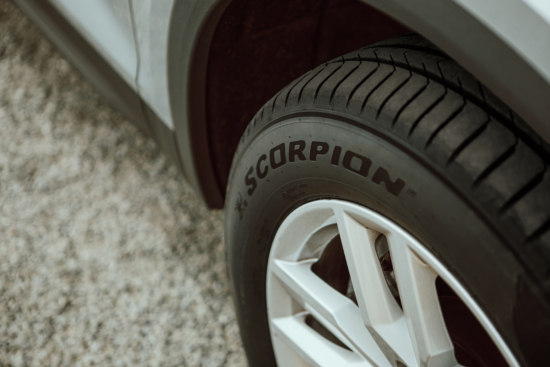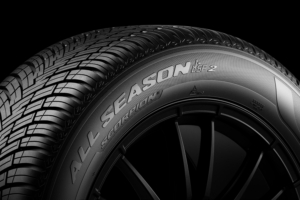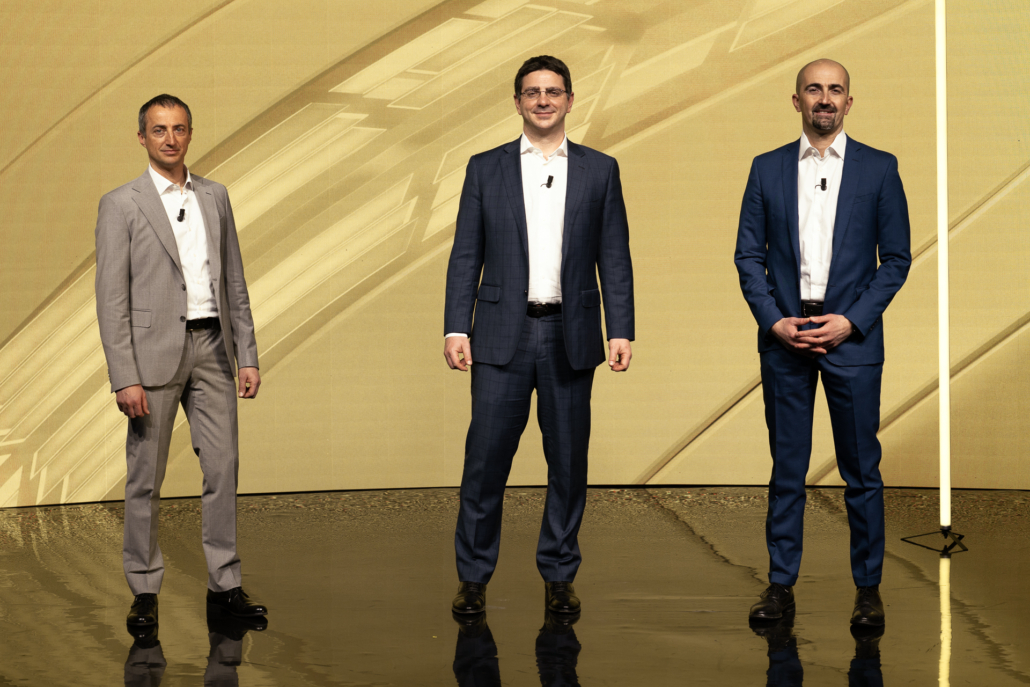Pirelli launches completely renewed Scorpion SUV tyre range
 The launch showcased the new summer Scorpion and the new Scorpion All Season SF2 in detail. At the same time, Pirelli previewed the Scorpion Winter 2 tyre (Photo: Pirelli)
The launch showcased the new summer Scorpion and the new Scorpion All Season SF2 in detail. At the same time, Pirelli previewed the Scorpion Winter 2 tyre (Photo: Pirelli)
Earlier today Pirelli launched a totally overhauled Scorpion SUV tyre range. In short, the company is taking great steps towards a leading position in the future electric SUV tyre market and is already dominating in the SUV/CUV tyre sector of today. With the new tyres scoring 100 per cent AB tyre label ratings as well as upwards of 7 per cent improvements across the range in wet and dry braking, the company is making a strong case that it can achieve its goals.
The launch showcased the new summer Scorpion and the new Scorpion All Season SF2 in detail. At the same time, Pirelli previewed the Scorpion Winter 2 tyre. The new tyres were presented by Francesco Sala, Pirelli’s executive vice president for Europe; Aldo Nicotera, chief commercial officer for Europe; and Paolo Brivio, chief of product development.
The latest Pirelli Scorpion summer tyre features a new asymmetrical tread pattern designed to offer better braking on both dry and wet surfaces compared to its predecessor (the Scorpion Verde). All the different sizes of Scorpion are in the A or B classes of the European tyre label when it comes to rolling resistance. Likewise, when it comes to wet braking, all Scorpion tyres score either A or B on the European tyre label. The fact that the Scorpion summer tyre offers 7 per cent improvements in wet and dry braking respectively will no-doubt have gone a long way to achieving that result The new Scorpion is also very quiet, emitting up to three decibels less than the previous-generation tyre, according to the European tyre label.
As well as construction, tyre compounds play a key role in any product’s improvement. The Scorpion Summer’s compound contains “new-generation synthetic rubber” capable of providing “low rolling resistance, excellent braking performance in the wet, and uniform tread wear throughout the life of the product”, according to Pirelli. Product development engineers report that compound know-how applied to the Cinturato P7 (albeit stiffened to cope with the particular demands of SUVs) formed the basis of recent developments in the Scorpion summer. Furthermore, the Scorpion compound was developed using a Pirelli-patented process derived from motorsport, maximising its uniformity “enhancing the performance of the tyre for longer on different road surfaces; especially in the wet”.
With that in mind, the new Scorpion is not only a strong overall performer, but is also more efficient when it comes to reducing fuel consumption (or battery consumption in the case of electric cars). Following the Eco-Safety approach, the structure of the tyre has been reinforced to cope with the dynamics and weight of SUVs during emergency manoeuvres, such as sudden direction changes or braking and is also designed to cope with significant loads.
The Scorpion summer tyre is available now in Europe in 26 sizes, ranging from 18 to 21 inches in diameter, with more than 48 homologations already, of which over 75 per cent are for electric vehicles. This means that the latest Scorpion tyre also comes with significant environmental benefits.
Scorpion All Season SF2

Like the summer variant, all the different sizes of Scorpion All Season SF2 (with the exception of those using run-flat technology) are in the A or B classes of the European label for rolling resistance (Photo: Pirelli)
The new Scorpion All Season SF2 is aimed at people who want to comply with winter tyre regulations but don’t want to bother with seasonal tyre changes. Judging by the temperature range this product is pitched at (roughly -2’C to +20’C) it is also aimed at drivers in temperate climates such as the UK that don’t have winter legislation. It’s available in 33 sizes between 17 and 21 inches in this launch phase and it is equipped with the 3PMSF (Three Peak Mountain Snowflake) European winter performance accreditation.
The Scorpion All Season SF2 features a compound and a tread pattern inspired by that of the Cinturato, with some unique peculiarities to cater for the specific characteristics of SUVs. The directional tread pattern of the Scorpion All Season SF2 is characterised by prominent V-shaped grooves that retain snow while draining water from the footprint when driving on wet roads and helping to prevent sudden aquaplaning.
The tyre also features 3D sipe technology, meaning that a winter tread pattern can effectively turn itself into a summer pattern. To cope with the driving dynamics and weight of SUVs, there are reinforced blocks in the tread (in a larger size compared to the Cinturato All Season SF2).
The tread compound of the Scorpion All Season SF2 is dual purpose: soft and adaptable for cold and wet conditions but rigid and stable for dry conditions. Like the summer variant, all the different sizes of Scorpion All Season SF2 (with the exception of those using run-flat technology) are in the A or B classes of the European label for rolling resistance. The compound also has a wider temperature operating window than the previous Scorpion, thanks to a more rigid compound. This means reduced tread wear and better performance from the tyre throughout its life, as well as a higher mileage: all of which is good news for the environment.
Scorpion Winter 2
The new winter tyre for SUVs builds on innovations pioneered by the Cinturato winter tyre, carrying them through into the world of SUVs, with a tread that features ‘extendable’ variable geometry sipes. Thanks to the 3D structure, these sipes also change shape according to the state of wear of the tread. The tread features roughly 51 metres of sipes that deliver greater grip on snow: an increase of 20 per cent of useful area compared to the previous Scorpion Winter. The tread blocks are also reinforced and larger than those on the Cinturato, to meet all the demands of modern SUVs and deliver greater grip, which leads to excellent braking and driving performance both on snow and wet surfaces. The Scorpion Winter 2’s compound was developed through the use of an “innovative system of liquid polymers” in order to improve performance in the rain and snow.
Capitalising on SUV and EV tyre trends
There is no question that motorists are increasingly switching to sports utility and crossover utility-type passenger cars (commonly abbreviated as SUVs and CUVs respectively). In the prelude to the launch of the Scorpion range, Pirelli executives illustrated the extent of the surge towards larger, sporty cars. According to Pirelli data, which includes both SUVs and CUVs in a catch-all figure, these vehicles occupied 20 per cent of the market in 2010. By 2020, that figure had more than doubled to half the market. Looking forward, Pirelli executives are predicting SUV take-up will hit 60 per cent by 2025.
At the same time, Pirelli is also adopting a leading position when it comes to officially homologated electric vehicle tyres. With a current total of 139 electric vehicle tyre product homologations under its belt, Pirelli now has 6 per cent more than the next nearest competitor via its growing Elect product designation. With the launch of the new tyres, Pirelli is aiming for the entire new Scorpion range to achieve more than 400 original equipment homologations, with more than 50 per cent of these for the latest electric vehicles.
As a result of Pirelli’s increasing focus on the SUV business, the Italian tyremaker now reports that the company is now sector market leader. Specifically, in the 19-inch and upwards SUV tyre sub-sector, 30 per cent of tyres sold in the top four European markets were Pirelli Scorpions, according to GfK data.
At the same time, market data shows that electric vehicle take-up is also accelerating at a rate of knots. Put the two together and you have a high-performance high-value electric SUV future – something that Pirelli clearly wants to play a key role in. Indeed, Pirelli expects 8.1 million SUV vehicle registrations by 2025 of which 20 per cent of new cars will be electric vehicles.
While much of the strategic emphasis of the most recent Pirelli launch focused the company’s efforts to capitalise on the nascent SUV and electric vehicle tyre take-up trends, Pirelli also sought to highlight its eco-credentials. Indeed, that is why Pirelli – a company with a low history of performance tyre associations – is presently trumpeting its ‘Eco-Safety’ design approach, which aims to combine low environmental impact (decreased rolling resistance, reduced road noise and high mileage) with “the best possible performance and safety”.

The new tyres were presented by Francesco Sala, Pirelli’s executive vice president for Europe; Aldo Nicotera, chief commercial officer for Europe; and Paolo Brivio, chief of product development (Photo: Pirelli)





Comments